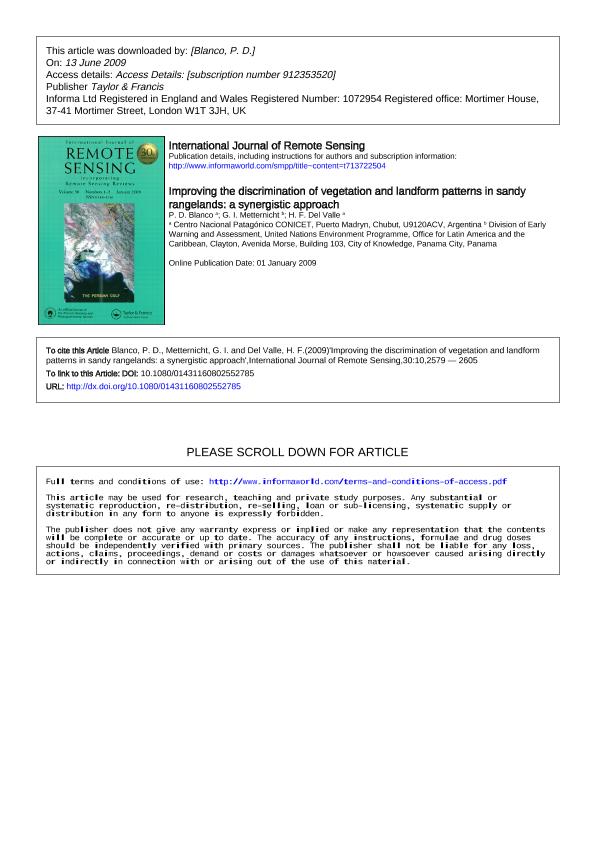Mostrar el registro sencillo del ítem
dc.contributor.author
Blanco, Paula Daniela

dc.contributor.author
Metternicht, Graciela

dc.contributor.author
del Valle, Hector Francisco

dc.date.available
2020-01-28T20:49:04Z
dc.date.issued
2009-05
dc.identifier.citation
Blanco, Paula Daniela; Metternicht, Graciela; del Valle, Hector Francisco; Improving the discrimination of vegetation and landform patterns in sandy rangelands: A synergistic approach; Taylor & Francis; International Journal of Remote Sensing; 30; 10; 5-2009; 2579-2605
dc.identifier.issn
0143-1161
dc.identifier.uri
http://hdl.handle.net/11336/96074
dc.description.abstract
Soil erosion is a key factor in land degradation processes in the sandy rangelands of the Peninsula Valdes of Patagonia, Argentina. Mapping landform and vegetation patterns is important for improving prediction, monitoring and planning of areas threatened by sand and shrub encroachment. This paper investigates the contribution of optical sensors, such as the Terra Advanced Spaceborne Thermal Emission and Reflection Radiometer (ASTER), and textural measures derived from microwave Radarsat Advanced Synthetic Aperture Radar (ASAR) to their discrimination. An evaluation is undertaken to compare the classification accuracy achieved by specific regions of the spectrum and their synergistic use in an object-oriented approach. Image segmentation and object-oriented classifications were applied to the datasets. This required defining appropriate fuzzy membership functions for characterizing active and stabilized lineal dunes and the main vegetation classes. Improvements in the discrimination of active and stabilized dunes (vegetated by either scrub or grass) were achieved by using an object-oriented classification that integrated microwave and visible near-infrared (NIR) data. Changes in surface roughness caused by different vegetation types stabilizing the dunes affected the radar backscattering. Whereas Radarsat enabled a clear separation of scrub-stabilized dunes, Terra-ASTER showed superior performance in the cartography of grass-stabilized dunes. The synergistic use of microwave and visible and near-infrared (VNIR) data yielded a substantial increase in the discrimination and mapping of landform/vegetation patterns.
dc.format
application/pdf
dc.language.iso
eng
dc.publisher
Taylor & Francis

dc.rights
info:eu-repo/semantics/openAccess
dc.rights.uri
https://creativecommons.org/licenses/by-nc-sa/2.5/ar/
dc.subject
ASTER
dc.subject
RADARSAT-1
dc.subject
LANDFORM MAPPING
dc.subject
VEGETATION PATTERNS
dc.subject.classification
Otras Ciencias de la Tierra y relacionadas con el Medio Ambiente

dc.subject.classification
Ciencias de la Tierra y relacionadas con el Medio Ambiente

dc.subject.classification
CIENCIAS NATURALES Y EXACTAS

dc.title
Improving the discrimination of vegetation and landform patterns in sandy rangelands: A synergistic approach
dc.type
info:eu-repo/semantics/article
dc.type
info:ar-repo/semantics/artículo
dc.type
info:eu-repo/semantics/publishedVersion
dc.date.updated
2019-12-12T14:50:16Z
dc.journal.volume
30
dc.journal.number
10
dc.journal.pagination
2579-2605
dc.journal.pais
Reino Unido

dc.journal.ciudad
Londres
dc.description.fil
Fil: Blanco, Paula Daniela. Consejo Nacional de Investigaciones Científicas y Técnicas. Centro Nacional Patagónico; Argentina
dc.description.fil
Fil: Metternicht, Graciela. United Nations Environment Programme; Panamá
dc.description.fil
Fil: del Valle, Hector Francisco. Consejo Nacional de Investigaciones Científicas y Técnicas. Centro Nacional Patagónico; Argentina
dc.journal.title
International Journal of Remote Sensing

dc.relation.alternativeid
info:eu-repo/semantics/altIdentifier/doi/http://dx.doi.org/10.1080/01431160802552785
dc.relation.alternativeid
info:eu-repo/semantics/altIdentifier/url/https://www.tandfonline.com/doi/full/10.1080/01431160802552785
Archivos asociados
